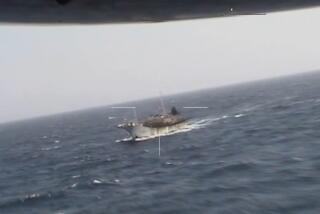Troubled waters: Why all the fuss in the South China Sea?
The South China Sea has been a source of friction for decades with China, the Philippines, Malaysia, Taiwan, Brunei and Vietnam all asserting claims over various sections.
The United States and its regional allies fear that China is now trying to establish effective control over parts of the strategic waterway through landfill and construction projects in the Spratly Islands, a group of contested reefs, islets and atolls.
On Tuesday, the U.S. sent a Navy warship into the 12-mile territorial zone claimed by China for artificial islands it is building to assert Washington’s position that the archipelago lies within international waters where ships from all nations are free to navigate.
The maneuver drew a sharp rebuke from Beijing, which warned Washington not to “cause trouble” in the South China Sea.
What is at stake?
The South China Sea, a 1.4-million-square-mile stretch in the western Pacific Ocean, is home to some of the world’s busiest shipping lanes. More than $5 trillion worth of international trade passes through every year, including as much as 50% of world oil tanker shipments.
The region also contains rich fishing grounds and is believed to hold significant oil and gas deposits. Increasing competition for those resources has fueled tension in the region and been a source of occasional skirmishing.
The accompanying military buildups have raised the stakes even further, analysts warn, increasing the potential for spats to escalate into armed conflict.
What has China been doing?
China claims authority over hundreds of islands within the controversial “nine-dash line,” an ill-defined loop encompassing most of the South China Sea.
It bases the claim on survey expeditions, fishing activity and naval patrols dating back as far as the 15th century. However, analysts note that the islands are mostly uninhabited, making the question of historical sovereignty difficult to sort out.
Among the largest and most contentious of these islands are those of the Spratly archipelago, where China has been dredging sand from tiny reefs and shoals to produce new islands and building military facilities.
An analysis of satellite imagery conducted by the Center for Strategic and International Studies in Washington shows the scope and speed of China’s reclamation efforts. In the last two years, Mischief Reef is estimated to have grown by nearly 6.7 million square yards and Subi Reef by 4.7 million square yards.
On Fiery Cross Reef, where the dredging has created an island nearly two miles long and several hundred yards wide, China has started building a 10,000-foot runway, long enough for most of its combat and support aircraft. Satellite photos also reveal the development of port facilities on the island.
What are other countries doing?
China is not alone in pursuing land reclamation projects or building military installations on contested islands. Vietnam, the Philippines and other countries have been taking similar steps for decades, although on a smaller scale.
Vietnam, for example, added nearly 78,000 square yards to West Reef and 25,000 square yards to Sand Cay island between 2011 and 2015, according to the CSIS analysis, which also reported new defensive structures going up on Sand Cay.
How has the U.S. responded to the disputes?
The U.S. hasn’t taken a position on the various competing claims in the South China Sea.
However, U.S. officials contend that the United Nations Convention on Laws of the Sea does not allow China to claim as sovereign territory islands built atop reefs that were submerged at low tide and to use them to assert claims to territorial waters.
The Obama administration has been signaling for months that it would send patrols into the 12-mile zone claimed by China to defend what it regards as freedom of navigation on international waters.
In May, a U.S. Navy surveillance plane flew near Fiery Cross Reef. Although it kept outside the 12-mile limit, a Chinese military dispatcher repeatedly warned the U.S. aircraft to leave the area.
The same month, a U.S. warship sailed through the Spratlys and was tailed by a Chinese navy vessel.
“Make no mistake, the United States will fly, sail and operate wherever international law allows, as we do around the world, and the South China Sea is not and will not be an exception,” Defense Secretary Ash Carter said this month.
Why are matters coming to a head now?
Buoyed by years of rapid economic growth, China has been building up its armed forces and projecting its influence with increasing assertiveness.
In the last three years, Beijing has deployed an oil exploration rig in waters near the Paracel Islands that are also claimed by Vietnam; driven Filipino fishermen from the Scarborough Shoal; and declared an air-defense-identification zone over islands also claimed by Japan in the East China Sea.
In the process, it has put pressure on the U.S., which has been increasing its military presence in the region as part of its “pivot” to Asia strategy.
Last month, China sent five military ships into international waters off the coast of Alaska, something it had never before attempted, according to U.S. officials.
Washington has in turn been trying to mobilize its allies in the region and helping to beef up their means of countering China’s expanding military ambitions.
The disputes over the South China Sea are likely to remain a source of distrust and suspicion despite efforts by Presidents Obama and Xi Jinping to deepen cooperation between their countries.
The Chinese Foreign Ministry said Tuesday that the country adheres to international law but “resolutely opposes the damaging of China’s sovereignty and security interests in the name of free navigation and flight.”
“China will firmly deal with provocations from other countries,” warned a statement posted on the ministry’s website.
Times staff writers Julie Makinen in Beijing and David S. Cloud in Washington contributed to this report.
For more international news, follow @alexzavis on Twitter
More to Read
Sign up for Essential California
The most important California stories and recommendations in your inbox every morning.
You may occasionally receive promotional content from the Los Angeles Times.










